On the occasion of Entrepreneurs’ Day held on August 20, President Shavkat Mirziyoyev engaged in a traditional dialogue with entrepreneurs. The event was attended by entrepreneurs and investors from all regions, and thousands of business representatives participated through regional studios.
Experts from the Center for Economic Research and Reforms (CERR) conducted an in-depth linguistic analysis of the President’s speech, which made it possible to identify the most frequently used keywords and semantic emphases.
The results of the linguistic analysis (based on the original text of the speech) demonstrated that the President focused attention on key issues of development, such as support for entrepreneurship, expansion of business opportunities, improvement of the tax and financial system, and the creation of new jobs.
The speech clearly emphasized that entrepreneurs are becoming the backbone of the country’s modernization. The President defined entrepreneurs as key partners of the state with whom an atmosphere of trust, openness, and progress is being created.
In total, the head of state used 4,241 words in his speech. The most frequently used were “tadbirkor” (entrepreneur) — 107 times, “business” — 34 times, “korxona” (enterprise) — 29 times, “soliq” (tax) — 21 times, along with “investment,” “loyiha” (project), and “credit” — 15 times each. Other actively used terms included “tizim” (system) — 14 times, “sharoit” (conditions), “bank,” and “startup” — 13 times each, as well as “export” — 12 times (Figure 1).
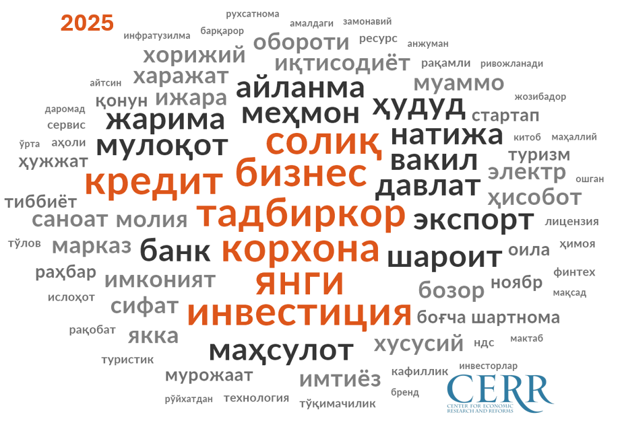
Particular attention was given to recurring expressions such as “biznes vakillari” (business representatives), mentioned 8 times, “ochiq muloqot” (open dialogue) — 7 times, and “imtiyozli kredit” (preferential credit) — 4 times. The President also repeatedly emphasized phrases such as “Yangi Oʻzbekiston” (New Uzbekistan), “kichik biznes” (small business), “yosh tadbirkor” (young entrepreneur), “yakka tadbirkor” (individual entrepreneur), “moliyaviy xizmatlar” (financial services), “aylanma mablagʻ” (working capital), and “eng ilgʻor” (most advanced) — all mentioned 3 times.
Among three-word combinations, “yakka tartibdagi tadbirkor” (individual entrepreneur) and “kuch – bu tadbirkorlar” (entrepreneurs are power) were used 3 times each. Other collocations included “aholi va tadbirkorlar” (population and entrepreneurs), “litsenziya va ruxsatnoma” (license and permit), “bogʻcha va maktab” (kindergarten and school), “kichik biznes uchun” (for small business), “imtiyozli kredit ajratiladi” (a preferential loan will be provided), “qoʻllab-quvvatlashga tayyorman” (ready to support), “qarzdorlik uchun jarima” (penalty for debt), “band qilgan shaxs” (employed person), and “oilaviy mehmon uylari” (family guest houses) — each used 2 times.
Thus, the speech structure demonstrates that the President consistently emphasized entrepreneurs as the driving force of reforms, as well as key aspects such as taxation, lending, investment, business conditions, and export stimulation.
The high frequency of these words indicates that the main focus of the speech was on supporting entrepreneurship, expanding investment and credit mechanisms, easing the tax burden, and boosting export potential.
Linguistic analysis of the past four years
The words that the head of state has used during the last four dialogues with entrepreneurs reveal certain trends. The word “tadbirkor” (entrepreneur) appears with the highest frequency, reflecting the central role of the entrepreneurial class in state policy. The frequency of the term “soliq” (tax) rose sharply in 2023 but declined in subsequent years, indicating the step-by-step resolution of issues in tax administration reform and the creation of preferential conditions (Figure 2).
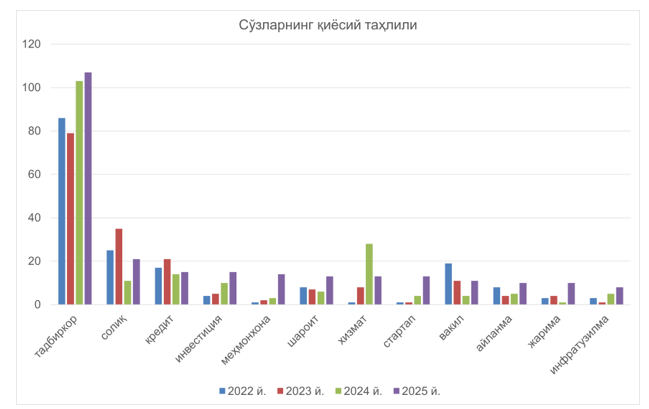
Such words as “credit” and “investment” have been used consistently, emphasizing the continuity of financing policies and capital attraction. The term “xizmat” (service) increased three- to fourfold in 2024 and remained central in 2025, underscoring the priority development of the service sector, including tourism, education, and healthcare, as key drivers of the economy.
The word “startup” rose sharply in 2025, reflecting the state’s special attention to innovation, the digital economy, and youth initiatives as a strategic direction. The terms “infratuzilma” (infrastructure) and “sharoit” (conditions) have also appeared more frequently in recent years.
The analysis of the past four years shows that the President’s focus in his speeches has gradually shifted from tax and credit policy to the development of services, startups, and infrastructure. This dynamic reflects the consistency of the country’s economic strategy, where support for entrepreneurship and the expansion of financing mechanisms have laid the foundation for the next stage — strengthening the role of services, innovation, and digital solutions as key drivers of national development.
The distribution of words by thematic areas shows that the President devoted the greatest attention to the legal environment and investment climate (21%), as well as financing and support for startups (17%) (Figure 3). Services and tourism (13%), textiles and industry (11%), tax reforms (10%), and small business support (8%) were also significant themes. Education, healthcare, infrastructure, and macroeconomic performance accounted for 6% each. This structure reflects a policy that combines legal and financial stability with the development of new economic drivers — services, innovation, and entrepreneurship.
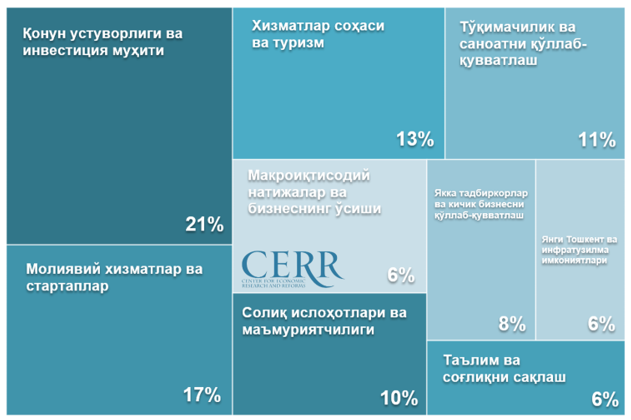
Thus, the overall distribution structure reflects a strategic course toward building a competitive economy in which the key areas are the legal and investment environment, financing and support for startups, the development of services, and the modernization of industry. The balance between traditional sectors (taxation, industry, macroeconomics) and new drivers (startups, services, innovation) demonstrates a comprehensive approach to shaping a modern growth model.
The analysis also shows that the President’s key priorities are closely connected with the most frequently used words. The terms “tadbirkor” (entrepreneur), “business,” “investment,” “credit,” and “bank” are concentrated around the areas of “legal environment and investment climate” and “financial services and startups,” confirming the course toward strengthening the role of entrepreneurs and expanding access to financing (Figure 4).
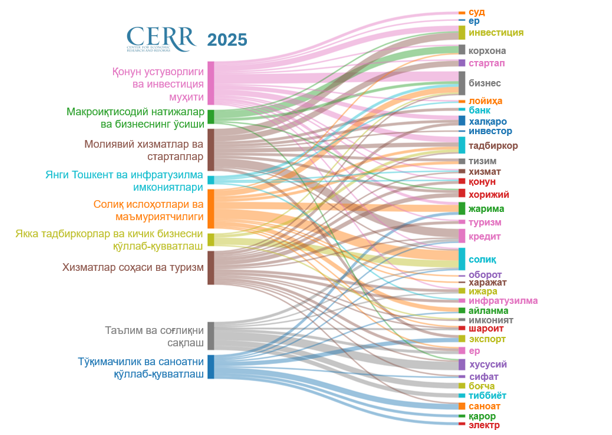
The words “soliq” (tax) and “qonun” (law) are associated with the block “tax reforms and administration,” reflecting the emphasis on transparency and legal guarantees for business.
The high frequency of “xizmat” (service), “tourism,” and “export” demonstrates the priority given to the development of the service sector and entry into foreign markets, which is linked to the areas of “services and tourism” and “export support.”
In addition, the term “infratuzilma” (infrastructure) corresponds to the block “New Tashkent and infrastructure opportunities,” highlighting the focus on long-term conditions for sustainable development.
Thus, the identified interconnections reflect a systemic approach: from supporting entrepreneurship and investment mechanisms to the development of services, innovation, and infrastructure as key factors of national growth.
Ilyos Rabbimov, CERR
Farhad Tutkaboev, CERR
CERR Public Relations Service










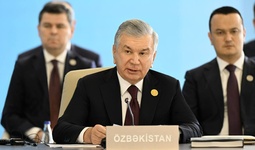
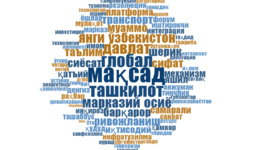













leave a comment